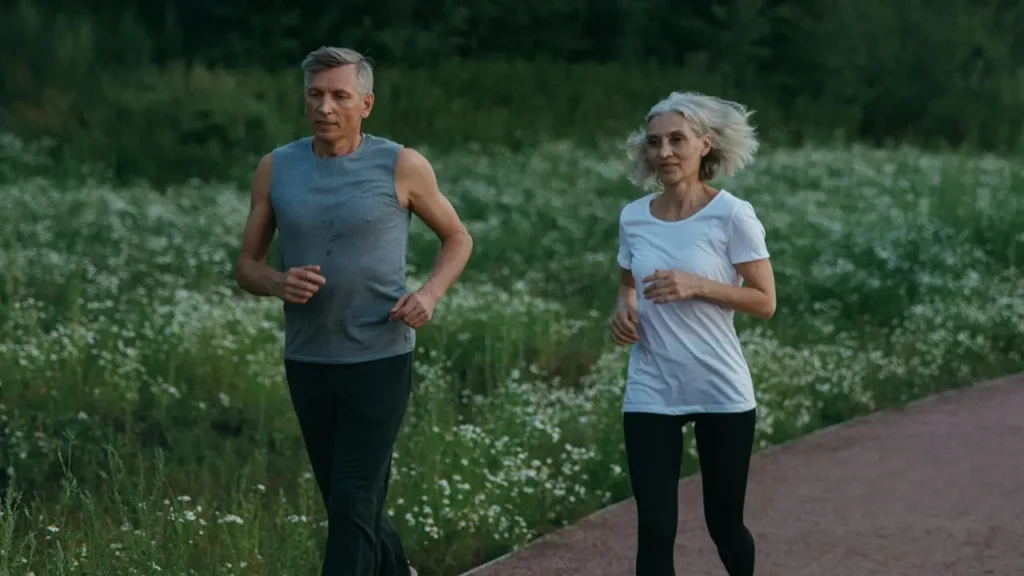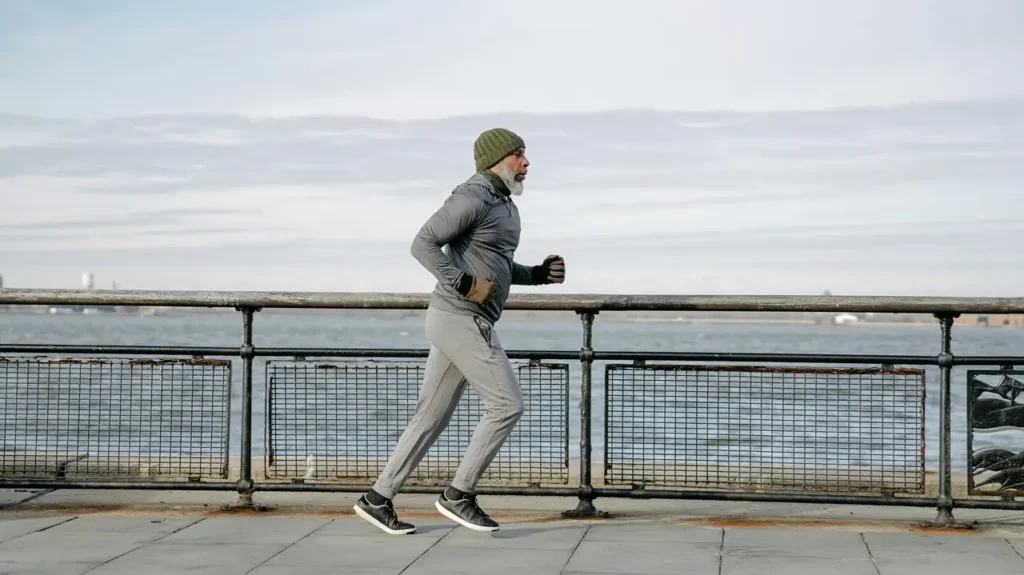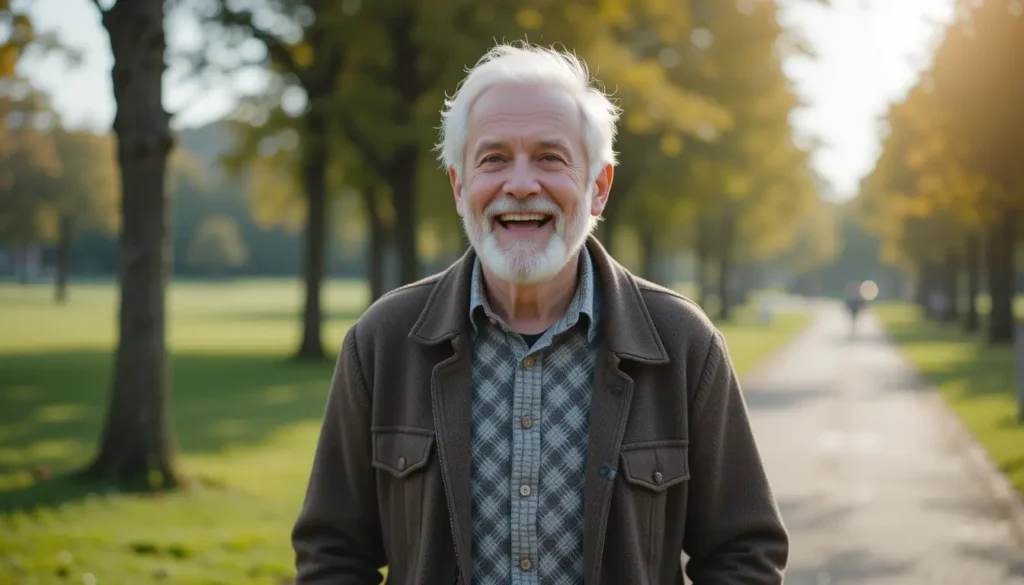Exercise is one of the most effective ways to slow down the aging process. Regular physical activity has been shown to have numerous benefits that counteract many of the negative effects of aging.
Here’s how exercise helps you slow aging:
- Preserves Muscle Mass
- Improves Cardiovascular Health
- Enhances Brain Function
- Reduces Inflammation
- Supports Bone Health
- Boosts Mitochondrial Function
- Regulates Hormones
- Increases Telomere Length
Preserves Muscle Mass and Strength
Sarcopenia (age-related muscle loss)is a common issue in seniors. This condition typically begins in your 30s and accelerates after the age of 50. Individuals loses about 3-8% of their muscle mass per decade.
But you can regain the muscle mass with proper exercise. Resistance training (e.g., weightlifting, bodyweight exercises) helps maintain and build muscle mass. Maintaining regular exercise, you will feel stronger and functional as you age.
In fact, studies have shown that older adults who engage in regular resistance training can regain up to 2.5 pounds of muscle mass in just 10 weeks, significantly improving their physical capabilities.
Strong musclessupport your joints and bones. Strong muscles along with stronger joints and bones reduce the risk of falls and fractures.
Muscles act as shock absorbers for your joints, and helps to prevent wear and tear on cartilage and ligaments.
Additionally, strong muscles improve proprioception (your body’s awareness of its position in space), which enhances balance and coordination. This is particularly important for older adults, as falls are a leading cause of injury and loss of independence in this population.
Improves Cardiovascular Health
Aging often brings an increased risk of cardiovascular diseases. Older people suffer from hypertension, heart attacks, and strokes. Arteries tend to stiffen, and plaque buildup occurs. This results in atherosclerosis.
Aerobic exercises like walking, running, cycling, or swimming improve heart health. These type of low impact exercises strengthen heart muscle, improve circulation, and lower blood pressure. Regular aerobic exercise has been shown to increase the efficiency of the heart, allowing it to pump more blood with less effort.
This reduces the strain on the heart over time and lowers the risk of developing high blood pressure.
Regular cardio exercisehelps reduce bad cholesterol (LDL) and increase good cholesterol (HDL). LDL cholesterol contributes to the buildup of plaque in the arteries, while HDL cholesterol helps remove excess cholesterol from the bloodstream.
Studies have shown that just 30 minutes of moderate-intensity aerobic exercise, such as brisk walking, five times a week can significantly improve cholesterol levels. Additionally, aerobic exercise improves endothelial function, which refers to the ability of blood vessels to expand and contract.
This helps regulate blood flow and reduces the risk of arterial stiffness. Over time, consistent aerobic activity leads to a healthier heart, better circulation, and a reduced risk of life-threatening cardiovascular events.
Enhances Brain Function and Cognitive Health
Exercise improves brain function and protects against cognitive decline. Physical activity increases blood flow to the brain. Exercise stimulates cells to deliver oxygen and nutrients to support brain health. This enhanced circulation removes waste products and toxins from the brain. This improves memory and attention.
It also stimulates the production of brain-derived neurotrophic factor (BDNF). BDNF isa protein that promotes the growth of new neurons and strengthens existing ones.
Neuroplasticity tends to decline with age. Older people face difficulty recovering from injuries due to this decline. BDNF plays a crucial role to improve neuroplasticity. Higher levels of BDNF have been linked to improved learning, better memory retention, and a reduced risk of neurodegenerative diseases like Alzheimer’s and Parkinson’s.
In fact, regular aerobic exercise can increase BDNF levels by up to 30%. This is a powerful protective effect against age-related cognitive decline.
Regular exercise has also been linked to improved memory, focus, and problem-solving skills. These cognitive benefits are not limited to older adults; younger individuals can also experience enhanced mental clarity and productivity through consistent physical activity.
Children who engage in regular physical activity perform better on academic tests, while adults report improved concentration and creativity after exercise. By promoting mental well-being, exercise creates an optimal environment for the brain to thrive.
Reduces Inflammation
Chronic inflammation is a key driver of many age-related diseases. As we age, the body’s inflammatory response become dysregulated.
Inflammation contributes to the breakdown of tissues, accelerates aging, and increases the risk of chronic illnesses. Exercise helps reduce systemic inflammation by promoting the release of anti-inflammatory molecules such as interleukin-6 (IL-6) and tumor necrosis factor-alpha (TNF-α). They help regulate the immune system and reduce harmful inflammatory responses. Additionally, exercise reduces the production of pro-inflammatory cytokines. Cytokine reduction helps to reduce obesity and metabolic syndrome.
Moderate, consistent exercise lower levels of inflammatory markers in the body. For instance, C-reactive protein (CRP), a common marker of systemic inflammation, tends to decrease with regular physical activity.
Furthermore, exercise improves gut health. A healthy gut microbiome produces short-chain fatty acids (SCFAs) that have anti-inflammatory properties. exercise promotes a diverse and balanced microbiome. By reducing inflammation, exercise not only protects against age-related diseases but also enhances recovery from injuries and infections.
Supports Bone Health
Reduction in bone density increases the risk of osteoporosis and fractures. This decline in bone mass is particularly pronounced in postmenopausal women due to the drop in estrogen levels.
Walking, jogging, and resistance training stimulate bone growth and help maintain bone density. When you engage in these activities, your bones are subjected to stress. This process triggers the release of bone-building cells called osteoblasts. These cells work to strengthen the bone tissue, making it denser and resilient over time.
As bones become stronger through exercise, they are better able to support the body’s structure. Poor posture lead to chronic pain, and an increased risk of falls. Additionally, strong bones are less likely to fracture in the event of a fall.
Boosts Mitochondrial Function

Mitochondria are the energy-producing structures within cells. Their function declines with age. This decline in mitochondrial efficiency is one of the hallmarks of aging.
Exercise improves mitochondrial function. During exercise, the demand for energy increases, prompting mitochondria to adapt by producing more ATP (adenosine triphosphate). Over time, this adaptation leads to the creation of new mitochondria (a process called mitochondrial biogenesis) and enhances the efficiency of existing ones.
Improved mitochondrial function is associated with increased energy levels, better muscle performance, and slower cellular aging. When mitochondria function optimally, you experience higher energy levels throughout the day.
Regulates Hormones
Hormonal changes are a natural part of aging. Hormones slows the aging process or it can increase it. Exercise can help regulate hormone levels. Regular physical activity helps balance insulin levels, and reduces the risk of type 2 diabetes. Exercise enhances the body’s ability to utilize glucose.
Additionally, exercise boosts levels of key hormones like testosterone and estrogen. In men, resistance training and high-intensity exercise have been linked to increased testosterone production. In women, regular physical activity helps regulate estrogen levels.
Exercise also helps manage stress hormones like cortisol.Chronically elevated cortisol accelerates aging. Cortisol secretion increasing aging process by weight gain, muscle loss, impaired immune function, and memory problems. Aerobic exercises lower cortisol levels.
Increases Telomere Length
Telomeres are protective caps at the ends of chromosomes that shorten as we age. These telomeres act as a buffer to protect our DNA during cell division. Each time a cell divides, the telomeres become slightly shorter. When telomeres become critically short, cells can no longer divide, leading to cellular senescence or death.
This process is closely associated with aging, and neurodegenerative disorders. Regular exercise preserves telomere length, and effectively slows down the cellular aging process.
exercise can have a profound impact on cellular health. Both aerobic and resistance training have been linked to longer telomeres. By protecting telomeres, exercise not only slows the aging process but also reduces the risk of chronic diseases.
Promotes Better Sleep
Sleep quality tends to decline with age. As we grow older, changes in sleep architecture make it harder to get restorative rest. Regular exercise helps regulate sleep patterns by promoting the natural release of melatonin. This hormone is responsible for regulating the sleep-wake cycle. Physical activity also helps reduce stress and anxiety, both of which are common culprits of insomnia or restless sleep.
Good sleep is essential for recovery, cognitive function, and emotional well-being. Deprived sleeps encourage aging. People who sleep less, look older. During deep sleep, the body undergoes tissue repair, and muscle growth. This is particularly important for older adults, who may need more time to recover from physical exertion or illness.
By improving sleep quality, exercise creates a virtuous cycle: better sleep leads to improved physical and mental health, which in turn makes it easier to stay active and slow the aging process.
Improves Skin Health
Exercise increases blood flow to the skin. It delivers nutrients that maintain skin elasticity and reduce the appearance of wrinkles. When you exercise, your heart pumps more blood throughout your body, including to the smallest capillaries near the surface of your skin. This increased circulation delivers essential nutrients like vitamins and antioxidants, which nourish skin cells and promote collagen production.
Collagen is a protein that gives skin its firmness and elasticity, and its production naturally declines with age. By boosting collagen synthesis, exercise keep your skin looking youthful and radiant.
Sweating during exercise helps clear out pores and detoxify the skin. Sweat contains water, salt, and small amounts of urea. These elements cleanse the skin by removing dirt, oil, and other impurities that clog pores. This natural cleansing process reduce the risk of acne, fine lines and age spots.
Exercise is a powerful anti-aging tool that benefits nearly every system in the body. Staying active help you maintain physical and mental health, and potentially extend your lifespan. By incorporating regular physical activity into your lifestyle, you can slow the aging process and enjoy a healthier, vibrant life as you grow older.




